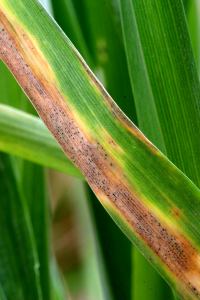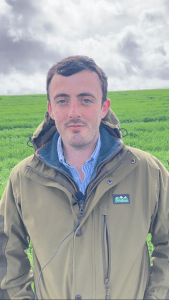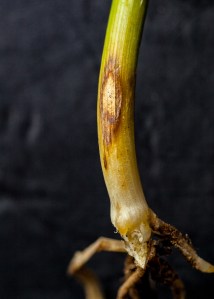Written by CPM Magazine from CPM Magazine
Download PDF
A wet early spring has favoured septoria and thrown fungicide strategies in the air. CPM investigates how four decision-makers from across the country are planning to manage the threat at T2.
By Will Charlton
Choosing a fungicide for T2 is one of the great gambles in the farming year. A decline in the wheat price from the highs of 2022, combined with increasing input costs, including hefty increases to fungicides, means that protecting yield as economically as possible is more critical than ever.

Julian Gold would like more of an IPM approach to disease control and use fewer fungicides, but the economic arguments for using fungicides make eliminating their use difficult.
Oxfordshire farmer Julian Gold says his approach is straightforward this season. It’s a fungicide’s performance against septoria that dictates his product choice, and he believes only a few options are up to the standard he expects.
Julian manages the 800ha Hendred Estate in South Oxfordshire, growing oilseed rape, winter wheat, winter barley, spring barley and beans. His wheat area is split between four varieties: Gleam, Graham, KWS Extase and Champion. Coming out of winter, his crops look well. However, Julian is concerned that the wet March has done little to encourage rooting, leaving them more susceptible to summer drought.
“I don’t believe I have many choices in the products I will use,” says Julian. “Across all the varieties I grow, I will use Univoq (prothioconazole+ fenpicoxamid) at T2, following a T1 application of Revystar (mefentrifluconazole+ fluxapyroxad).
“Univoq seems to have gone up less in price than other fungicides, and it’s the best product against septoria. I will adjust the rate according to the variety and pressure at T2 and I should be able to use a lower rate for Champion and Extase.”
Julian says another option for these more resistant varieties could have been Ascra (prothioconazole+ fluopyram+ bixafen) at T1, followed by Revystar at T2. However, using the same products across his whole wheat area and adjusting the rates is easier.
“I would like more of an IPM approach to disease control and use fewer fungicides, but the economic arguments for using fungicides make eliminating their use difficult. Even on the most resistant varieties, it always pays to use a fungicide at T2,” he says.
The much-publicised issues with Univoq last year were a consideration when he planned his fungicide programme. “Last year, some farmers locally had issues with spray equipment after applying Univoq. I’ve always used higher water volumes, so I had no problem using it at T2 with a water volume above 130 l/ha.
“One of the reasons I’ve used Revystar at T1 is the ability to tank mix PGRs and herbicides as the crop needs. This is less of an issue at T2, so I can apply Univoq alone with a high water volume and avoid potential sprayer complications,” explains Julian.
A high percentage of varieties susceptible to disease and a tendency for early drilling means that Agrii agronomist Craig Herkes expects a robust T2 in these situations.

East, west, south or north – septoria is the disease of the moment, though resistant varieties are showing their value.
Craig advises over 5000ha, covering The Borders, East Lothian and Fife. Most of his customers select their wheat varieties with the local distilling end market in mind. This enables them to capture a premium and, with most of the maltsters based in their locality, cut down on haulage costs.
However, the most popular biscuit and soft-feed wheat varieties are susceptible to disease. This is exacerbated by a tendency to drill in September and early October to ensure the crop is well-established before the winter begins.
“The most widely grown varieties in my area are LG Skyscraper, Elation, KWS Barrell and Elicit,” says Craig. “They all have a four or five rating for septoria, with weaknesses to yellow and brown rust. Early drilling means that the septoria score can be deducted by at least one when we evaluate the risk when planning our fungicide programmes.
“So far this spring, I’ve seen lots of septoria in all varieties, and yellow rust is particularly apparent in Skyscraper. Some crops were drilled later in the autumn, after potatoes, and have significantly less disease; however, yellow rust and mildew are always a concern in this situation. Considering our varieties, drilling date and rainfall, the current foliar disease pressure is not unusual leading up to T2,” says Craig.
“Cold waterlogged soils in early spring mean the area is a hotspot for stem-based disease. SRUC has always done its eyespot trials in East Lothian, which indicates how much of an issue it can be. Controlling fusarium, microdochium, and eyespot requires a programmed approach.
“Although the new chemistry is excellent at controlling foliar disease, I worry it does little to prevent these diseases. Because of this, I try to control them at T0 and T3 using tebuconazole and prothioconazole,” he says.
Looking ahead to T2 decisions, Craig believes it hinges on the variety choice and drill dates, with crops receiving an appropriate fungicide. “We have to manage disease responsibly with the correct tools. Once a crop has been drilled on a specific date with a particular variety, the disease risk must be adequately addressed. Savings can be made in fungicide programmes, but only when the situation allows.
“Revystar and Univoq have to be considered at T2 in high-pressure situations. Both give good control of septoria. Univoq is interesting because it provides a different mode of action and where I’m planning to use Univoq, I’ve reserved it for T2. It may not suit every situation, like on varieties susceptible to brown rust or where a farmer has a sprayer equipped with pulse width modulation.
“Revystar is a great option to fit alongside Univoq,” believes Craig. “It controls a broader spectrum of diseases and has greater dose rate flexibility. I will recommend both fungicides, depending on the situation.”

It has been several years since James Whatty seen the septoria pressure he’s now seeing in crops.
“I have had to re-write the same recommendation four times,” says Hutchinsons agronomist James Whatty when summarising how the season has gone so far. “It has been several years since I have seen the septoria pressure I’m now seeing in crops.”
James advises on a wide range of crops in mid-Cornwall, the most significant being wheat, barley and maize. The wet spring weather has led to very high septoria pressure, compounded by few farmers being able to apply a T0 fungicide. Despite the high disease pressure, he believes crops in his area have good yield potential. Dry weather in February allowed farmers to apply early nitrogen as planned, which has resulted in good nutrient uptake and crop biomass.
Hard wheat varieties, grown for animal feed, predominate in his area, the most popular being Graham, Extase, and more recently SY Insitor and Champion. “At the minute, Extase is suffering particularly badly from septoria. It’s early to develop in the spring, and leaves have emerged over poor weather windows. Champion is standing out as looking particularly promising. Those crops are uniform and the disease pressure is noticeably lower. This is encouraging because I urge my customers to grow newer varieties with better disease resistance.
“Fungicide timing has been particularly tricky this year. Many crops have one main bold tiller, with additional smaller tillers. This has led to variable leaf emergence, especially with leaf three. The levels of septoria lower in the canopy are huge with leaves 5 and 6 fully infected. I believe this has been exacerbated by salt burn and tipping, allowing disease into the leaf,” says James.

A combination of early drilling, poor varietal resistance and weather conditions mean eyespot is prevalent in some crops this spring.
T2 decisions will be a balancing act. Falling commodity prices mean that fungicide spend is understandably being challenged. However, failing to control disease when the pressure is high could result in yield losses. James’s T2 fungicide will be based on mefentrifluconazole, or mefentrifluconazole+ fluxapyroxad (Revystar). Although Univoq is a good fit for the southwest and the particularly high septoria pressure this year, there are a lot of caveats which have put growers off using the fungicide, he says, particularly in a season with limited weather windows and multiple crops to cover.
He cautions against relying too much on one group of chemistry. “I may be forced to use two applications of a mefentrifluconazole-containing product if the pressure is bad, but it’s not ideal. Because of this, most of my T2 fungicides will follow a T1 application of prothioconazole plus tebuconazole tank mixed with a bixafen plus fluopyram-containing product,” says James.
Norfolk-based independent agronomist Craig Green believes that the weather so far this spring has provided the perfect conditions for septoria to thrive in what is typically a lower-pressure part of the country.
“Septoria favours three climatic conditions,” explains Craig. “Temperatures ranging from 6-20⁰C, which it has been for the second half of March and April. Next is rain splash and parts of my area had over 100mm of rain and only two dry days in March. Finally, septoria development requires 16 hours of leaf wetness in a day. We’ve had two such days just this week [early April], so the situation is set for septoria to jump up the canopy as leaves emerge.
“I advise on 1200ha of land managed using regenerative farming practices, where we have been able to get away with very little fungicide use in the past few years. This year’s septoria pressure means I will have to recommend more than I initially expected to maintain the green leaf area,” he says.

Variety choice has helped to lower the pressure, says Craig Green. Although this year, he can easily see septoria on varieties rated as a seven for the disease.
Like in the southwest, hard wheat varieties grown for feed are the most popular in Craig’s area. “My customers favour Extase, LG Typhoon, Champion, Dawsum, Graham and Gleam. Last year was a lousy year for yellow rust, which heavily influenced farmers’ choices for sowing last autumn.
“There was a step change towards growing varieties more resistant to septoria the year after we lost chlorothalonil. Variety choice has helped to lower the pressure, although this year I can easily see septoria on varieties rated as a 7 for the disease.
“Most of my T2s will follow Ascra at T1. It may not be as strong as Revystar on septoria, but it’s effective against eyespot, which all of my most popular varieties have a weakness against. To account for the higher pressure, I have increased the dose rate by 25% from what I originally planned,” says Craig

For many agronomists Univoq is the product of choice with septoria threatening, though some growers remain wary of the associated sprayer complications experienced last season.
For T2, the conversation has been dominated by the pros and cons of Revystar and Univoq. Craig believes that Univoq is the better fungicide of the two overall. Its activity is more protective, meaning the spray timing must be correct. In contrast, Revystar is more curative, which is advantageous for growers who struggle to spray their whole acreage on the appropriate day.
“I have been trying to steer my customers towards Univoq as I believe it’s the right product for the season. It should provide the best control and works out 35% cheaper than an equivalent dose of Revystar,” he says.
“However, Univoq seems to be a Marmite product on-farm. Farmers who got on well with it last year like it, especially when they see the saving they can make. Those who experienced problems with spray equipment, or heard accounts of them, will not take the risk. The farmers will decide, and I will recommend Univoq or Revystar accordingly,” he adds.
It’s unusual to find a similar level of disease pressure across the country halfway through the season. Many farmers and agronomists would have to think back to 2012 to remember a year when the whole country faced a septoria epidemic. Then the rain began in April and didn’t stop through the summer. However, the weather is increasingly fickle and early-season showers could quickly turn into a summer heatwave, halting septoria in its tracks…
This article was taken from the latest issue of CPM. For more articles like this, subscribe here.
Sign up for Crop Production Magazine’s FREE e-newsletter here.
The post T2 decisions loom appeared first on cpm magazine.
Continue reading on CPM website...
If you are enjoying what you read then why not considering subscribing here: http://www.cpm-magazine.co.uk/subscribe/
Download PDF
A wet early spring has favoured septoria and thrown fungicide strategies in the air. CPM investigates how four decision-makers from across the country are planning to manage the threat at T2.
“The situation is set for septoria to jump up the canopy as leaves emerge.”
By Will Charlton
Choosing a fungicide for T2 is one of the great gambles in the farming year. A decline in the wheat price from the highs of 2022, combined with increasing input costs, including hefty increases to fungicides, means that protecting yield as economically as possible is more critical than ever.

Julian Gold would like more of an IPM approach to disease control and use fewer fungicides, but the economic arguments for using fungicides make eliminating their use difficult.
Oxfordshire farmer Julian Gold says his approach is straightforward this season. It’s a fungicide’s performance against septoria that dictates his product choice, and he believes only a few options are up to the standard he expects.
Julian manages the 800ha Hendred Estate in South Oxfordshire, growing oilseed rape, winter wheat, winter barley, spring barley and beans. His wheat area is split between four varieties: Gleam, Graham, KWS Extase and Champion. Coming out of winter, his crops look well. However, Julian is concerned that the wet March has done little to encourage rooting, leaving them more susceptible to summer drought.
“I don’t believe I have many choices in the products I will use,” says Julian. “Across all the varieties I grow, I will use Univoq (prothioconazole+ fenpicoxamid) at T2, following a T1 application of Revystar (mefentrifluconazole+ fluxapyroxad).
“Univoq seems to have gone up less in price than other fungicides, and it’s the best product against septoria. I will adjust the rate according to the variety and pressure at T2 and I should be able to use a lower rate for Champion and Extase.”
Julian says another option for these more resistant varieties could have been Ascra (prothioconazole+ fluopyram+ bixafen) at T1, followed by Revystar at T2. However, using the same products across his whole wheat area and adjusting the rates is easier.
“I would like more of an IPM approach to disease control and use fewer fungicides, but the economic arguments for using fungicides make eliminating their use difficult. Even on the most resistant varieties, it always pays to use a fungicide at T2,” he says.
The much-publicised issues with Univoq last year were a consideration when he planned his fungicide programme. “Last year, some farmers locally had issues with spray equipment after applying Univoq. I’ve always used higher water volumes, so I had no problem using it at T2 with a water volume above 130 l/ha.
“One of the reasons I’ve used Revystar at T1 is the ability to tank mix PGRs and herbicides as the crop needs. This is less of an issue at T2, so I can apply Univoq alone with a high water volume and avoid potential sprayer complications,” explains Julian.
A high percentage of varieties susceptible to disease and a tendency for early drilling means that Agrii agronomist Craig Herkes expects a robust T2 in these situations.

East, west, south or north – septoria is the disease of the moment, though resistant varieties are showing their value.
Craig advises over 5000ha, covering The Borders, East Lothian and Fife. Most of his customers select their wheat varieties with the local distilling end market in mind. This enables them to capture a premium and, with most of the maltsters based in their locality, cut down on haulage costs.
However, the most popular biscuit and soft-feed wheat varieties are susceptible to disease. This is exacerbated by a tendency to drill in September and early October to ensure the crop is well-established before the winter begins.
“The most widely grown varieties in my area are LG Skyscraper, Elation, KWS Barrell and Elicit,” says Craig. “They all have a four or five rating for septoria, with weaknesses to yellow and brown rust. Early drilling means that the septoria score can be deducted by at least one when we evaluate the risk when planning our fungicide programmes.
“So far this spring, I’ve seen lots of septoria in all varieties, and yellow rust is particularly apparent in Skyscraper. Some crops were drilled later in the autumn, after potatoes, and have significantly less disease; however, yellow rust and mildew are always a concern in this situation. Considering our varieties, drilling date and rainfall, the current foliar disease pressure is not unusual leading up to T2,” says Craig.
“Cold waterlogged soils in early spring mean the area is a hotspot for stem-based disease. SRUC has always done its eyespot trials in East Lothian, which indicates how much of an issue it can be. Controlling fusarium, microdochium, and eyespot requires a programmed approach.
“Although the new chemistry is excellent at controlling foliar disease, I worry it does little to prevent these diseases. Because of this, I try to control them at T0 and T3 using tebuconazole and prothioconazole,” he says.
Looking ahead to T2 decisions, Craig believes it hinges on the variety choice and drill dates, with crops receiving an appropriate fungicide. “We have to manage disease responsibly with the correct tools. Once a crop has been drilled on a specific date with a particular variety, the disease risk must be adequately addressed. Savings can be made in fungicide programmes, but only when the situation allows.
“Revystar and Univoq have to be considered at T2 in high-pressure situations. Both give good control of septoria. Univoq is interesting because it provides a different mode of action and where I’m planning to use Univoq, I’ve reserved it for T2. It may not suit every situation, like on varieties susceptible to brown rust or where a farmer has a sprayer equipped with pulse width modulation.
“Revystar is a great option to fit alongside Univoq,” believes Craig. “It controls a broader spectrum of diseases and has greater dose rate flexibility. I will recommend both fungicides, depending on the situation.”

It has been several years since James Whatty seen the septoria pressure he’s now seeing in crops.
“I have had to re-write the same recommendation four times,” says Hutchinsons agronomist James Whatty when summarising how the season has gone so far. “It has been several years since I have seen the septoria pressure I’m now seeing in crops.”
James advises on a wide range of crops in mid-Cornwall, the most significant being wheat, barley and maize. The wet spring weather has led to very high septoria pressure, compounded by few farmers being able to apply a T0 fungicide. Despite the high disease pressure, he believes crops in his area have good yield potential. Dry weather in February allowed farmers to apply early nitrogen as planned, which has resulted in good nutrient uptake and crop biomass.
Hard wheat varieties, grown for animal feed, predominate in his area, the most popular being Graham, Extase, and more recently SY Insitor and Champion. “At the minute, Extase is suffering particularly badly from septoria. It’s early to develop in the spring, and leaves have emerged over poor weather windows. Champion is standing out as looking particularly promising. Those crops are uniform and the disease pressure is noticeably lower. This is encouraging because I urge my customers to grow newer varieties with better disease resistance.
“Fungicide timing has been particularly tricky this year. Many crops have one main bold tiller, with additional smaller tillers. This has led to variable leaf emergence, especially with leaf three. The levels of septoria lower in the canopy are huge with leaves 5 and 6 fully infected. I believe this has been exacerbated by salt burn and tipping, allowing disease into the leaf,” says James.

A combination of early drilling, poor varietal resistance and weather conditions mean eyespot is prevalent in some crops this spring.
T2 decisions will be a balancing act. Falling commodity prices mean that fungicide spend is understandably being challenged. However, failing to control disease when the pressure is high could result in yield losses. James’s T2 fungicide will be based on mefentrifluconazole, or mefentrifluconazole+ fluxapyroxad (Revystar). Although Univoq is a good fit for the southwest and the particularly high septoria pressure this year, there are a lot of caveats which have put growers off using the fungicide, he says, particularly in a season with limited weather windows and multiple crops to cover.
He cautions against relying too much on one group of chemistry. “I may be forced to use two applications of a mefentrifluconazole-containing product if the pressure is bad, but it’s not ideal. Because of this, most of my T2 fungicides will follow a T1 application of prothioconazole plus tebuconazole tank mixed with a bixafen plus fluopyram-containing product,” says James.
Norfolk-based independent agronomist Craig Green believes that the weather so far this spring has provided the perfect conditions for septoria to thrive in what is typically a lower-pressure part of the country.
“Septoria favours three climatic conditions,” explains Craig. “Temperatures ranging from 6-20⁰C, which it has been for the second half of March and April. Next is rain splash and parts of my area had over 100mm of rain and only two dry days in March. Finally, septoria development requires 16 hours of leaf wetness in a day. We’ve had two such days just this week [early April], so the situation is set for septoria to jump up the canopy as leaves emerge.
“I advise on 1200ha of land managed using regenerative farming practices, where we have been able to get away with very little fungicide use in the past few years. This year’s septoria pressure means I will have to recommend more than I initially expected to maintain the green leaf area,” he says.

Variety choice has helped to lower the pressure, says Craig Green. Although this year, he can easily see septoria on varieties rated as a seven for the disease.
Like in the southwest, hard wheat varieties grown for feed are the most popular in Craig’s area. “My customers favour Extase, LG Typhoon, Champion, Dawsum, Graham and Gleam. Last year was a lousy year for yellow rust, which heavily influenced farmers’ choices for sowing last autumn.
“There was a step change towards growing varieties more resistant to septoria the year after we lost chlorothalonil. Variety choice has helped to lower the pressure, although this year I can easily see septoria on varieties rated as a 7 for the disease.
“Most of my T2s will follow Ascra at T1. It may not be as strong as Revystar on septoria, but it’s effective against eyespot, which all of my most popular varieties have a weakness against. To account for the higher pressure, I have increased the dose rate by 25% from what I originally planned,” says Craig

For many agronomists Univoq is the product of choice with septoria threatening, though some growers remain wary of the associated sprayer complications experienced last season.
For T2, the conversation has been dominated by the pros and cons of Revystar and Univoq. Craig believes that Univoq is the better fungicide of the two overall. Its activity is more protective, meaning the spray timing must be correct. In contrast, Revystar is more curative, which is advantageous for growers who struggle to spray their whole acreage on the appropriate day.
“I have been trying to steer my customers towards Univoq as I believe it’s the right product for the season. It should provide the best control and works out 35% cheaper than an equivalent dose of Revystar,” he says.
“However, Univoq seems to be a Marmite product on-farm. Farmers who got on well with it last year like it, especially when they see the saving they can make. Those who experienced problems with spray equipment, or heard accounts of them, will not take the risk. The farmers will decide, and I will recommend Univoq or Revystar accordingly,” he adds.
It’s unusual to find a similar level of disease pressure across the country halfway through the season. Many farmers and agronomists would have to think back to 2012 to remember a year when the whole country faced a septoria epidemic. Then the rain began in April and didn’t stop through the summer. However, the weather is increasingly fickle and early-season showers could quickly turn into a summer heatwave, halting septoria in its tracks…
This article was taken from the latest issue of CPM. For more articles like this, subscribe here.
Sign up for Crop Production Magazine’s FREE e-newsletter here.
The post T2 decisions loom appeared first on cpm magazine.
Continue reading on CPM website...
If you are enjoying what you read then why not considering subscribing here: http://www.cpm-magazine.co.uk/subscribe/





